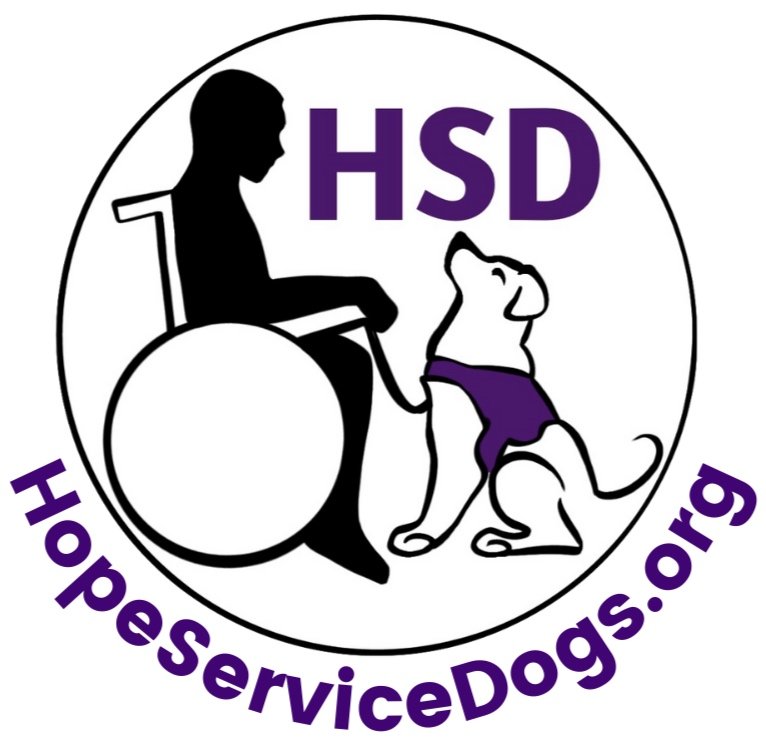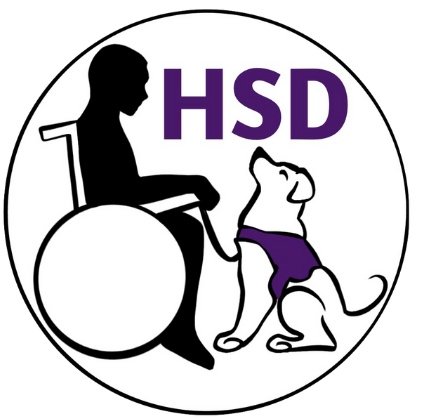Traveling by Air With Service Animals
The U.S. Department of Transportation (Department or DOT) issued a final rule to amend the Department's Air Carrier Access Act (ACAA) regulation on the transport of service animals by air. This final rule is intended to ensure that our air transportation system is safe for the traveling public and accessible to individuals with disabilities.
Hope Service Dogs, Inc is proud that our feedback was used to make this ruling.
A Rule by the Transportation Department on 12/10/2020:
Regarding the issue of whether airlines should be permitted to reject service animal documents that are stale (e.g., dated more than one year before the date of travel), the comments that we received on this issue tended to center on the Health Form, because, as proposed, a veterinarian would have been required to fill out the form. The American Kennel Club and Hope Service Dogs agreed with the Department's proposal that its DOT Health Forms should be valid for a period of one year because the forms can be readily completed during the service animal's annual physical.[154]
One disability advocacy organization, however, disagrees with the Department's proposal that airlines should also consider physical indicators, such as vests, harnesses, etc., when trying to decide an animal's status. Hope Service Dogs, Inc. commented that DOT's regulation should never permit airlines to look at vests, harnesses, certificates, and identification badges as proof that a dog is a trained service dog because a service dog only requires a plain collar or a harness and a regular leash.[187]
On April 6, 2020, Victoria Warfel posted this comment as feedback for the DOT:
We believe that the DOT should change their definition of a Service Animal:
1) to Service Dog, in that only dogs are recognized as service animals. It needs to be clarified that a Psychiatric Service Dog is in fact a Service Dog. It has gone through all of the same training as any other Service Dog except in the training of its tasks. This is the same as a SD trained for mobility has different task training than a SD trained for guiding or for medical alert tasks. There is sometimes an overlap, but the training is based on the needs of the individual handler. There is a difference between a Psychiatric Service Dog and an Emotional Support Dog and the two should never be classed together. As with all Service Dogs, they have been trained to do task(s) or work to mitigate the disability of their individual handler.
2) to have the DOT and DOJ in agreement on a more common definition
3) The airlines should never look at vests, harnesses, certificates, and identification badges as proof that a dog is a trained Service Dog. A SD only requires a plain collar or harness and a regular leash to be worn. Anything else is used as a aid of the handler in using the SD for their needs.
4) Some teams may have special ID cards which may also have a picture of the dog. Usually included are the dog's name and the name and contact info of the handler.
Some training facilities may issue a certificate or card upon the dog completing the requirements set up by that individual organization. This shows that the dog passed those requirements at that particular time. Such items are not to be used as a form of ID that the dog is a Service Dog.
5) In following the guidance of the DOJ, we believe that a well-trained Service Dog may come from any breed or mixture of breeds and may be of any size. We further believe that the handler should be willing to sign a form stating that the Service Dog has been trained in basic obedience and worked with enough that the handler is certain that the dog will behave in a non-aggressive manner during the boarding, the flight and unloading from the plane. They are also certain that the dog is of no danger to other animals or people while on the airport property.
If the dog has not reached full Service Dog status and is being transported on the flight as a Service Dog In Training for training purposes, the handler attests to the fact that the dog has shown by its training to date, that it is of proper temperament to be safe to be transported by plane.
6) For safety reasons we do not believe that untrained dogs should fly in the same manner as a well-trained service dog. If someone needs to fly with an animal for emotional support, that animal should follow the same rules as a companion animal ie. pet. They should be contained in the same manner as any pet; that is, secured in an approved carrier for the duration of flight. To clarify, the animal should not be taken out of the carrier at any time while in the plane, except in extreme circumstances that are approved by a flight staff member. If the airline wishes they can waive or reduce any pet fees for those Emotional Support animals, but all other regulations should stand.
We also believe for safety reasons and the comfort of other passengers, all service animals (and pets and ESAs in their carriers) should remain on the floor in the owner's foot space and not be allowed to fly on the owner's lap. A dog does not need to be next to an owner's face to detect and alert to a medical condition.
A Service Dog should never try to solicit attention from other passengers or flight crew. At the same time, members of the flight crew should refrain from talking to or trying to get the attention of the Service Dog.
7) A service animal should be tethered to the owner in the same manner as required under the DOJ while doing Public Access. While in the confines of an aircraft, a dog will not need to be free to seek assistance or to retrieve items for the disabled handler.
8) Service Dogs should be required to have an up-to-date form (within one year) signed by a veterinarian to attest that the dog is current on Rabies Vaccination (as required by law). That the dog is free of any infestation - at that time - such as fleas,, ticks etc.
A veterinarian is not the same as an animal behaviorist and is not able to attest to how safe a dog might be on a flight. This is a legal point on which many veterinarians have already stated they will not sign the current proposed health certificates.
9) We also believe that it is unrealistic and an undue burden on those who need and use a Service Dog, to require them to check in 3 hours before their flight. This is not required by those customers who are not disabled and do not use a Service Dog.

